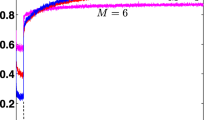Abstract
This paper deals with direction-of-arrival (DOA) estimate problem based on multiple signal classification (MUSIC) criterion with particle swarm optimization (PSO) for code-division multiple access signals. It is shown that the computational complexity and estimate accuracy of the traditional spectral searching MUSIC estimator strictly depends on the number of search grids used during the search. The more accurate DOA estimation, the more searching grids are needed. In conjunction with PSO algorithm, the computational complexity of DOA estimation of MUSIC estimator can be reduced, while the accuracy of estimation performance can be enhanced. But, the optimum solution searching and the convergence of standard PSO iteration process are restricted by using the linearly decreasing intra weights the hard limited conditions of particles moving velocities and position clipping. To promote accurate DOA finding, a modified PSO estimator with the decision strategy of particle velocities and particle position clipping is presented in this paper. In addition, this paper also presents adaptive multiple inertia weights with Newton–Raphson method to speeding up the convergence of modified PSO iteration process. Several computer simulation examples are provided for illustration and comparison.





Similar content being viewed by others
References
Caffery, J. J., & Stuber, G. L. (1998). Overview of radiolocation in CDMA cellular networks. IEEE Communications Magazine, 36(4), 38–45.
Schmidt, R. O. (1986). Multiple emitter location and signal parameter estimation. IEEE Transaction on Antennas and Propagation, 34(3), 276–280.
Chiang, C. T., & Chang, A. C. (2003). DOA estimation in the asynchronous DS-CDMA system. IEEE Transaction on Antennas and Propagation, 51(1), 40–47.
Rao, B. D., & Hari, K. V. S. (1989). Performance analysis of root-MUSIC. IEEE Transactions on Acoustics, Speech and Signal Processing, 37(12), 1939–1949.
Chang, A. C., & Hung, J. C. (2010). Combining GA and INWES approach to DOA estimation of CDMA signals. Neural Computing and Applications, 19(7), 1003–1011.
Shi, Y., & Eberhart, R. (May 1998). A modified particle swarm optimizer. In IEEE International Conference on Evolutionary Computation, Anchorage, Alaska (pp. 69–73).
Shi, Y., & Eberhart, R. (2000). Comparing inertia weights and constriction factors in particle swarm optimization. In Proceedings of the Congress on Evolutionary Computation, Piscataway (Vol. 1, pp. 84–88).
Shi, Y., & Eberhart, R. (1998). Comparison between genetic algorithms and particle swarm optimization. In Lecture Notes in Computer Science (Vol. 1447, pp. 611–616).
Li, M., & Lu, Y. (2008). Maximum likelihood DOA estimation in unknown colored noise fields. IEEE Transactions on Aerospace and Electronic Systems, 44(3), 1079–1090.
Li, M., & Lu, Y. (2009). Source bearing and steering-vector estimation using partially calibrated arrays. IEEE Transactions on Aerospace and Electronic Systems, 45(4), 1361–1372.
Yang, B., & Zhang, Q. (2010). Frame sizing and topological optimization using a modified particle swarm algorithm. In 2010 Second WRI Global Congress on Intelligent Systems. China: Wuhan.
Luenberger, D. G., & Ye, Y. (2008). Linear and nonlinear programming (3rd ed.). New York, USA: Springer Science + Business Media Limited Liability Company.
Golub, G. H., & Van Loan, C. H. (1996). Matrix computations. Baltimore, MD, USA: The Johns Hopkins University Press.
Eberhart, R. C., & Shi, Y. (2001). Particle swarm optimization: Development, applications and resources. In Proceedings of the 2001 Congress on Evolutionary Computation, Seoul, South Korea (Vol. 1, pp. 81–86).
Hu, X., Shi, Y., & Eberhart, R. C. (2004). Recent advances in particle swarm. In Proceedings of Congress on Evolutionary Computation (Vol. 1, pp. 90–97)
Shi, Y., & Eberhart, R. C. (1998). Parameter selection in particle swarm optimization. In: Proceedings of 7th International Conference, San Diego, California, USA (pp. 591–601).
Soo, K. K., Siu, Y. M., Chan, W. S., Yang, L., & Chen, R. S. (2007). Particle-swarm-optimization-based multi-user detector for CDMA communications. IEEE Transactions on Vehicular Technology, 56(5), 3006–3013.
Shi, Y., & Eberhart, R. C. (1999). Empirical study of particle swarm optimization. In Proceedings of the Congress on Evolutionary Computation (Vol. 3, pp. 1945–1950).
Author information
Authors and Affiliations
Corresponding author
Rights and permissions
About this article
Cite this article
Meng, CL., Chen, SW. & Chang, AC. Direction-of-Arrival Estimation Based on Particle Swarm Optimization Searching Approaches for CDMA Signals. Wireless Pers Commun 81, 343–357 (2015). https://doi.org/10.1007/s11277-014-2132-1
Published:
Issue Date:
DOI: https://doi.org/10.1007/s11277-014-2132-1




